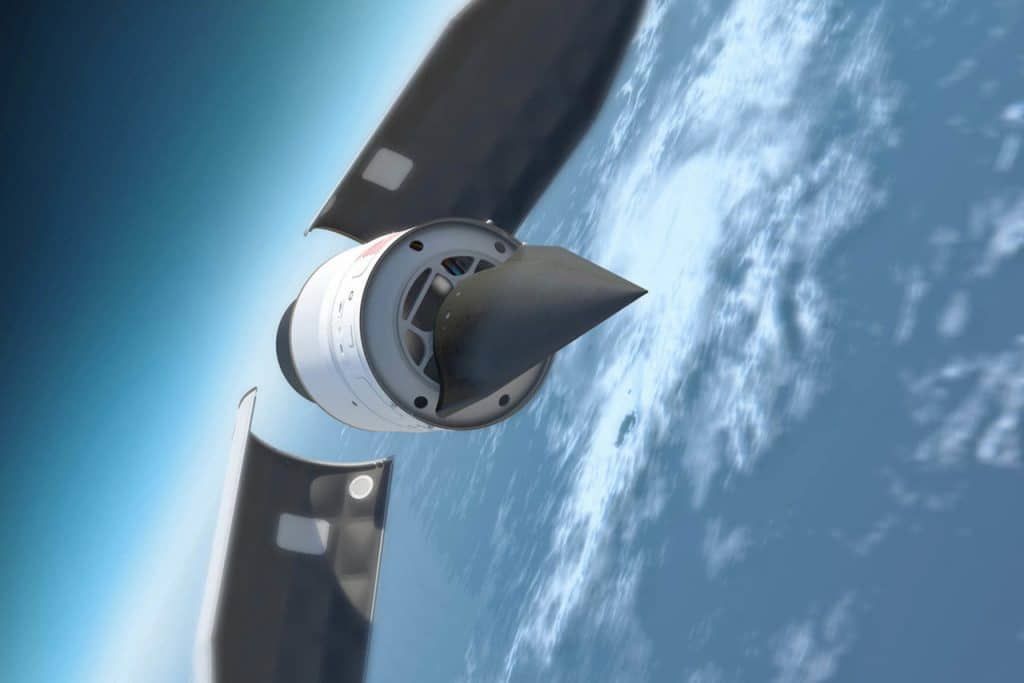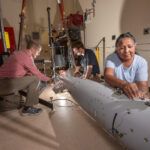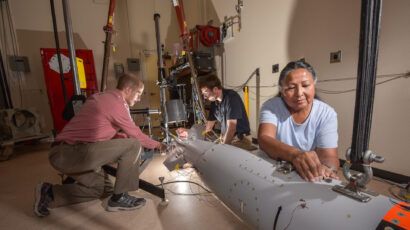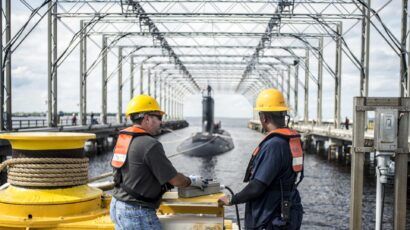Hypersonic missiles: Why the new “arms race” is going nowhere fast
By Andrew W. Reddie | January 13, 2020
 An illustration depicting the US Falcon Hypersonic Test Vehicle. Image courtesy of DARPA.
An illustration depicting the US Falcon Hypersonic Test Vehicle. Image courtesy of DARPA.
Speaking on December 24, 2019, Russian President Vladimir Putin marked the deployment of Russia’s first nuclear-capable hypersonic missile system, noting, “Today, we have a unique situation in our new and recent history. [Other countries] are trying to catch up with us. Not a single country possesses hypersonic weapons, let alone continental-range hypersonic weapons.”
The question that is now facing policy makers in Washington, Beijing, London, and elsewhere is whether and how this deployment reshapes strategic stability.
The answer, perhaps counterintuitive amid the hand-wringing over Moscow’s announcement, is not much. In reality, the systemic consequences of hypersonic missiles will be minimal to nil, and the narrative that Washington is “behind” in a hypersonic arms race fails to take into account the different strategic challenges facing China, Russia, and the United States—not least that the United States need not overcome an adversary’s missile defense systems.
Maneuverable missiles. Hypersonic missiles travel faster than Mach 5 (approximately 3,800 miles per hour) and have the ability to maneuver during flight. Existing research and design efforts associated with hypersonic weapons have focused on two types of missile technologies. The first, a boost-glide vehicle, is designed to sit on top of an existing ICBM and to be launched on a normal ballistic trajectory before being released and maneuvering to a target without any additional propulsion. Russia’s recently-deployed Avangard system serves as an example of this type of hypersonic weapon. The second type, perhaps more complex to develop and deploy, is a hypersonic cruise missile. This type of weapon involves a supersonic combustion ramjet or turboramjet engine that would provide in-flight propulsion, and this feature would allow it to travel at significantly lower altitude than its boost-glide counterpart. In both cases, though these missiles are named for their speed, it is their potential maneuverability that represents the central concern surrounding the effects of their deployment.
Hypersonics and missile defense. Just as missile defense systems represent an antidote to traditional nuclear missiles that travel on a ballistic trajectory, hypersonic weapons represent an innovation to overcome these defenses. As a result, it is difficult to discuss the strategic effects of hypersonic weapons without taking into account the current state missile defense capabilities.
Among those who frame hypersonic weapons as a strategic game-changer, there are three aspects of missile defense that are too often ignored. First, missile defense technologies remain in their infancy, with the United States the only country possessing significant numbers of deployed missile defense systems. Second, US capabilities are explicitly deployed to deter North Korea and Iran—not peer or near-peer competitors like Russia or China. As the 2019 Missile Defense Review notes, “Today’s US missile defenses provide significant protection against potential North Korean or Iranian ballistic missile strikes against the US homeland, and will improve as necessary to stay ahead of missile threats from rogue states.” Finally, amid a mixed test record with debates surrounding the appropriateness of test conditions, it remains unclear whether existing US missile defense technologies are as successful as policy makers might like.
In light of the above and in the near term, Moscow’s deployment of hypersonic nuclear weapons changes little. Given that US missile defense systems are not designed to address the threat posed by peer competitors with large numbers of nuclear weapons, the vulnerability of the United States to a nuclear attack from Russia is the same in January 2020 as it was in November 2019, prior to Russia fielding this class of weapon. The fact that both Washington and Moscow rely on their respective mutual vulnerability—not missile defense technologies—to deter nuclear warfare remains unchanged. Among those who theorize that missile defense itself is destabilizing, hypersonic missiles may actually strengthen strategic stability by reinforcing rather than degrading the mutual vulnerability upon which nuclear deterrence rests.
Characterizing the hypersonic “arms race.” Alongside concerns surrounding strategic stability, US policy makers have also expressed concern that the United States is “behind” in a hypersonic arms race—with deployment of US hypersonic capabilities currently slated for 2022.
To the extent to which there is a “race” surrounding hypersonic weapon systems at all, Russia and China do enjoy an advantage in the development of hypersonic technology—measured by the number of successful hypersonic weapon tests. Prior to Putin’s announcement, China’s DF-ZF boost-glide vehicle had achieved the most success in testing, while India and France are reported to be close behind.
Against the backdrop of a historical record in which Moscow has long had more diverse nuclear options compared to the United States, what should military analysts make of the US failure to develop and deploy hypersonic weapons first?
The answer: very little.
As noted above, the United States is the primary developer of missile defense technologies, with Moscow and Beijing registering their objections to various US deployments in Europe and East Asia over the past two decades. Amid concerns that US missile defense systems might eventually be used against them—and particularly in the absence of their own missile defense capabilities—investment in hypersonic weapons makes sense for both Moscow and Beijing. In the language of strategists, research and development of hypersonic weapons represent a “hedge” against future advancements in US missile defense technologies. This driver is not present for the United States. As such, nuclear-armed hypersonic weapons would provide few if any appreciable benefits to the existing US nuclear capabilities encapsulated in the nuclear triad. This reality is also reflected in the fact that the current research and development programs in the United States focus on conventional rather than nuclear payloads for hypersonic weapon systems. Others have also noted that this conventional focus increases the accuracy requirements of US hypersonic weapons—which may explain some of the delay in their deployment.
Commentary suggesting that increased US investment in hypersonic weapons is needed to “match” or “lead” are also incongruous with the various offset strategies used by the United States to engage in military competition over the past six decades. For example, faced with superior Russian conventional forces in Europe in the 1950s, Eisenhower armed a much smaller US ground force with battlefield nuclear weapons—using a technological solution to asymmetrically compensate for a strategic disadvantage. More recently, the third offset strategy sought to “include autonomous learning systems for handling big data and determining patterns, human-machine collaboration for more timely relevant decision making, and assisted human operations”—and using these technological capabilities as a force multiplier. In both cases, military planners did not seek to match an adversary capability for capability. Instead, they sought a policy solution that addressed the underlying strategic threat. These offset strategies offer benefits both in terms of flexibility and reducing the resource cost of strategic competition, and it is unclear why this logic would be abandoned in the context of hypersonic missile threats.
Hypersonic risks. So, should we be concerned about hypersonic weapons?
In terms of both systemic consequences and the US position on the proverbial hypersonic leaderboard, the answer is no.
There are, however, real—if largely ignored—concerns that hypersonic weapons deployed in regional contexts (to assure allies, for example) may increase the risks of inadvertent escalation. The development and deployment of conventional hypersonic missile systems may also lead to a failure among parties in a conflict to discriminate between conventional and nuclear attacks.
Instead of worrying that hypersonic weapons are revolutionizing warfare, or that adversaries are ahead, it is these incremental concerns that should be the focus for both scholars and policy makers moving forward.
Together, we make the world safer.
The Bulletin elevates expert voices above the noise. But as an independent nonprofit organization, our operations depend on the support of readers like you. Help us continue to deliver quality journalism that holds leaders accountable. Your support of our work at any level is important. In return, we promise our coverage will be understandable, influential, vigilant, solution-oriented, and fair-minded. Together we can make a difference.
Keywords: Avangard, China, Russia, United States, arms race, hypersonic missiles, strategic stability
Topics: Analysis, Disruptive Technologies, Nuclear Weapons















It is a myth that U.S. missile defense is primarily to counteract attacks from N. Kore and Iran! /As this article states. Many, Including Russia, understand this.
Just look at where the US systems are deployed. They are right where NK or Iranian missiles would fly. Thirty or so hit-to-kill ABM systems are not a threat to Russia or China.
Developing nuclear weapons that don’t have to enter space and therefore don’t show up on norad seems destabilizing.
I don’t disagree with the overall conclusion that hypersonics are not a significant need for the US. However, the statement that the US is only country with a deployed ABM system is flat wrong. Russia has fielded nuclear-armed ABM missiles around Moscow for decades. en.wikipedia.org/wiki/A-135_anti-ballistic_missile_system
This article ignores the conventional war threat of the Russian hypersonic missiles. The Kh-47M2 Kinzhal (“Dagger”) for example, moves at Mach 12, is maneuverable, and can be armed with either a nuclear or conventional warhead. The U.S. has no defense to it. But a single Dagger can take out a nuclear-powered aircraft carrier using a conventional warhead. That revolutionized naval warfare.
But here we are, still building more aircraft carriers.